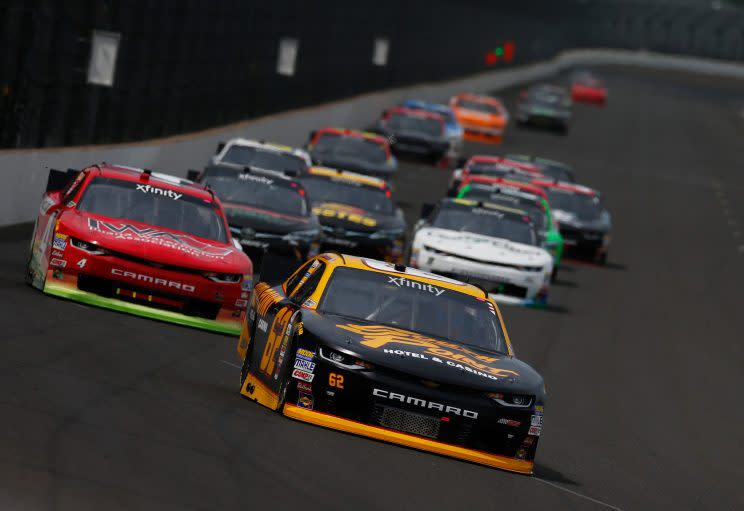The Xfinity Series Indianapolis tweaks made a difference; so what's next?
INDIANAPOLIS — This sure didn’t look like a one-and-done.
WIlliam Byron won Saturday’s Xfinity Series race at Indianapolis after holding off Paul Menard in a thrilling final few laps unlike anything seen before in an Xfinity race at Indianapolis Motor Speedway.
Admittedly, those are some exceptionally low standards. Ever since NASCAR moved the Indianapolis Xfinity Series race to the hallowed 2.5-mile speedway from the Lucas Oil Raceway short track 20 minutes to the west, the racing has been pretty awful.
Against the standards of any other track on the Xfinity Series schedule, Saturday’s race probably ranks solidly above average. Which, by the standards set at IMS, means it was an exceptional race.
NASCAR’s new rules mandating restrictor plates on the engines and aero ducts on the front of cars to disperse air around the sides and promote a larger wake for trailing cars to take advantage of produced 16 lead changes (the previous record was nine) and the closest finish in the six Xfinity Series races at the track.
That close finish is what NASCAR wanted to see at Indianapolis. Much like at Daytona and Talladega, NASCAR didn’t want the leader being able to gap the field like in previous races. Over the last two seasons, Kyle Busch led 115 of a possible 163 laps in his two victories at IMS.
“I think a great race is the objective,” NASCAR vice president Steve O’Donnell said. “What fans saw today was that. Certainly, it passed the eye test. Speeds, some races you go 200, some you’re in the 100s on a road course. At the end of the day, what matters is how many lead changes did you have and was it competitive throughout, and we thought it was today.”
Unlike Daytona and Talladega, restrictor plates and the larger wake created by the ducts in the front of the cars were not the great equalizer. At Daytona and Talladega, underfunded teams have a shot at getting a top five or top 10 based off crashes and the variables pack racing and the draft creates.
The separation between the haves and have nots was still massive on Saturday like in previous Indy races. Cars that didn’t have a chance a year or two ago still didn’t have a chance. They were simply grouped closer together with cars of a similar level.
“We never thought this would be Daytona or Talladega,” O’Donnell said. “The first subjective to us was could you close the gap first to second. We certainly saw that with the leader not really getting out that far today all day long. You saw some stretches with 2-3 cars and kind of a gap between those. That’s something we want to evaluate. Is there a better ability to close that gap during the race and certainly look at that.”
Joey Logano, who finished third, said he wasn’t immediately ready to analyze the possible carryover of the rules setup to the Cup Series for the 2018 race at Indianapolis. Given that NASCAR’s changes produced a markedly different — and certainly not worse — race than previous Xfinity ones, it’s easy to think similar rules could be in the works for NASCAR’s top level next season.
Much like the Xfinity Series, the Cup Series has struggled to put on shows with lots of passing in recent years at Indianapolis. And NASCAR has shown previously it’s willing to change the Cup rules at Indy. In 2015, the race was run with a “high drag” rules setup that included taller spoilers. The changes — which hadn’t been run in a race anywhere previously — didn’t work and were scrapped after the season.
Changing the rules for Indy would also correspond nicely with the date change of the Brickyard 400. The race moves to September as the regular-season finale in 2018. It’s a move designed to bolster fan attendance, something that has lagged harshly since the 2008 tire debacle at the track, and help re-establish the prestige the Brickyard 400 once held in the minds of many.
While O’Donnell said it would be “tough to say” without more research if the changes made for the Xfinity Series would be compatible with Cup cars, he noted that they weren’t a “drastic change” either.
If we were betting on what the rules for next year’s 400 will look like, we’d wager that they’ll look a lot closer to the rules in Saturday’s race than what will be used Sunday.
“I’d say that we’d be more concerned if we didn’t have something to look at, a comparison between today and what happens tomorrow [in the Brickyard 400], but I’m confident at end of day, we’ll put on a good race tomorrow, and then we’ll evaluate the pros and cons from each and see where we go,” O’Donnell said.

– – – – – – –
Nick Bromberg is the editor of Dr. Saturday and From the Marbles on Yahoo Sports. Have a tip? Email him at nickbromberg@yahoo.com or follow him on Twitter!



